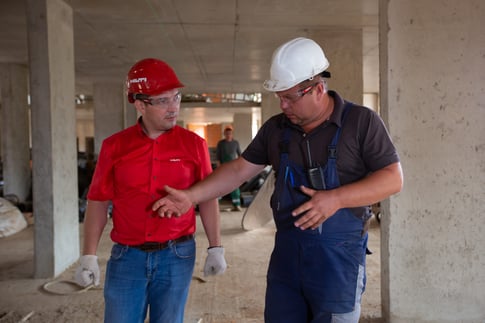In part one of this two-part series, we outlined how Building Enclosure Commissioning (BECx) is utilized to document the design and performance of the building enclosure, components, and systems. As we discussed, the BECx process typically starts in the pre-design consulting phase, continues through the construction phase and is evaluated during the occupancy phase.
In part two, we will explore what BECx Groups are looking for, discuss the testing used to ensure proper compliance, examine the scope of BECx Group’s responsibilities and determine what happens post commissioning.
The importance of BECx cannot be overstated. BECx should be initiated as early as possible to reduce the potential for rework or delays and to have the largest impact on the selection of building enclosure components. In addition, engaging the BECx process early ensures that the building being constructed will meet owner expectations and perform optimally.
What Are the Commissioners Looking for?

During each phase, BECx providers and testing agents evaluate the building enclosure design and construction to minimize or eliminate potential compatibility, performance, or constructability issues. They work to confirm materials were installed in accordance with the design documents and industry standards. Building deficiencies are identified and reviewed with the design and construction teams for correction, and testing is repeated to ensure success.
The lack of a thorough BECx process often leads to building failures and legal consequences. For example, in 2016, a high-profile lawsuit related to a construction defect in California resulted in a settlement of tens of millions of dollars due to the faulty installation of door and window flashing. These construction failures included improper drainage and faulty waterproofing membranes that caused water infiltration and corrosion of the private balconies and elevated walkways.
The commissioning process can identify potential defects before construction, preventing costly change orders, construction delays and potential lawsuits. In the end, BECx saves building owners countless hours of stress and millions of dollars.
The Importance of BECx Component Coordination Meetings
During the BECx process, coordination meetings are held regularly to review construction progress, confirm testing schedules and detail modifications.
Meetings include the owners, architects, the construction manager, the general contractor, and any sub-trades. During the meetings, members will review and coordinate shop drawing details and determine which enclosure components interface. Discussion of field observations, schedule and tracking logs should occur to familiarize team members and resolve outstanding items.
The Importance of Shop Drawing Reviews
Shop drawings are an essential element of the procurement process. Shop drawings are typically required for pre-fabricated components such as windows, cladding, roofing, waterproofing and air barrier systems. They delineate the specific fabrication and installation necessities of the given item and installer.
The information presented is intended to be a blueprint for the contractor. The BECx process includes a review of the documents needed for sequencing, constructability and coordination between system components.
The shop drawing review may also identify compatibility issues and deviations from the construction drawings prior to construction. At the coordination meetings, the shop drawing should be reviewed with the enclosure sub-trades for transition issues.
The Importance of On-Site Mockups

After the shop drawing reviews are complete, the mock-up process begins. Depending on the project complexity, a laboratory or on-site mock-up may be considered.
The on-site mock-up provides the opportunity to review design elements for compatibility with the selected products and the planned method for installation. Through building the mock-up, the installers have time to review sequencing and detailing prior to full construction.
Mock-ups should be considered valuable as no two installations are ever the same, even when utilizing similar materials. Often, the actual method or process of installation may be different.
In addition, mock-ups often incorporate unique details that should be tested for compatibility, water and air leakage, thermal anomalies, and durability.
Mock-ups should be created by the same people planning to work on the project; otherwise, issues may arise, costing both time and money due to unfamiliarity. If a mock-up is created by a seasoned crew but the actual project is built by people who are inexperienced with the selected materials, any number of avoidable problems may arise. After all, this is part of the importance of mock-ups — just as materials are verified, contractors should be verified as well.
BECx Field Testing
The BECx process will identify pre-construction, mock-up, and in-place field testing based upon the Owner Project Requirements. Unlike other commissioning processes, BECx requires testing throughout the construction phases in order to test building material components and systems prior to concealment by subsequent layers.
The BECx process should not rely only on design and testing at the closeout phase, as concealed components complicate diagnostics and repairs. If problems are found then they'll need to be solved before the testing phase continues. Once solutions are in place, the tests are repeated to ensure compliance. Some tests may include:
- Performance modeling during the development phase.
- Manufacturer material testing for custom or unique applicators. Project specific testing may be required if project requirements vary from standard testing.
- Compatibility testing of adjacent or overlapping materials.
- Laboratory mock-up testing prior to fabrication of off-site or prefabricated components.
- Periodic on-site tests of components following installation.
Depending on the building type, these are the most common tests performed:
- Air and water filtration
- Water penetration of waterproofing
- Infrared roof scan for energy loss
- Sealant inspection and testing
- Vapor barrier penetrations
- Window penetrations
- Adhesion testing
- Compatibility testing
BECx Group Responsibilities
The BECx Group’s responsibilities vary depending on the project phase. During the design phase, the BECx Group will work with the owners, architects and designers to gather information on the purpose of the building.
In the construction phase, the BECx Group will work closely with the owner, the construction manager, the general contractor, the subcontractor, manufacturers, and independent testing laboratories to ensure that the building meets required specifications.
During the occupancy phase, the BECx Group will work with the owners and maintenance providers in the building. The BECx process continues throughout the lifecycle of the building and monitors warranty enforcement, seasonal testing, and maintenance training.
The OPR (Owner's Project Requirements) is a document that is created by the BECx Group at the start of every project. The OPR provides basic information to assist the project team in planning, designing, constructing and maintaining a durable building enclosure.
The OPR is maintained and adjusted as the project evolves to ensure proper documentation for monitoring the performance goals, cost expectations and operational benchmarks of the building over time. A final OPR presented to the project team should include the entirety of all relevant information.
Contractor Responsibilities During Commissioning
The BECx Group works closely with contractors and project managers to ensure the construction site is accessible when needed for review and testing. BECx providers will coordinate with the contractor to include the shop drawing reviews, mock-ups and field testing within the project schedule.
The contractor should provide access to lifts, ladders, and any other necessary equipment so testing can proceed. The testing agency may also require water, power, and other critical systems to complete the tests.
Post Commissioning — What Happens?

The BECx Group responsibilities don’t end after the final report is submitted. They follow the building through its occupancy phase and ensure the staff is properly trained on building enclosure systems maintenance.
During the post-occupancy phase, the BECx Group will develop a Building Enclosure Maintenance Manual. According to the National Institute of Building Sciences, the Building Enclosure Maintenance Manual should include an overview of all enclosure types and systems with the purpose and location of each component.
In order to verify the building is performing to expectations, the team will conduct periodic, seasonal walkthroughs for warranty purposes and ongoing monitoring. The building performance observations will be shared with the owner, architect and construction teams.
A maintenance and inspection schedule is included, along with warranties, record drawings, submittals, attic stock listing, spare parts and storage location, as well as a recommended service schedule and replacement schedule. The purpose of this document is to provide information to the building's owners, maintenance staff and engineers to ensure the building is properly maintained over time.
Conclusion
BECx can seem complicated but it is a vital tool to maximizing the ultimate efficiency and performance of any building project.
The commission process allows a third-party to review, observe, and establish confidence and assurance in that the building and owner’s project requirements are being complied with throughout each and every step of the design and construction process.
We understand that BECx can be tricky to understand, but hopefully, this article provides helpful insights and actionable knowledge. For more information about BECx, please refer to part one of this two part series.






